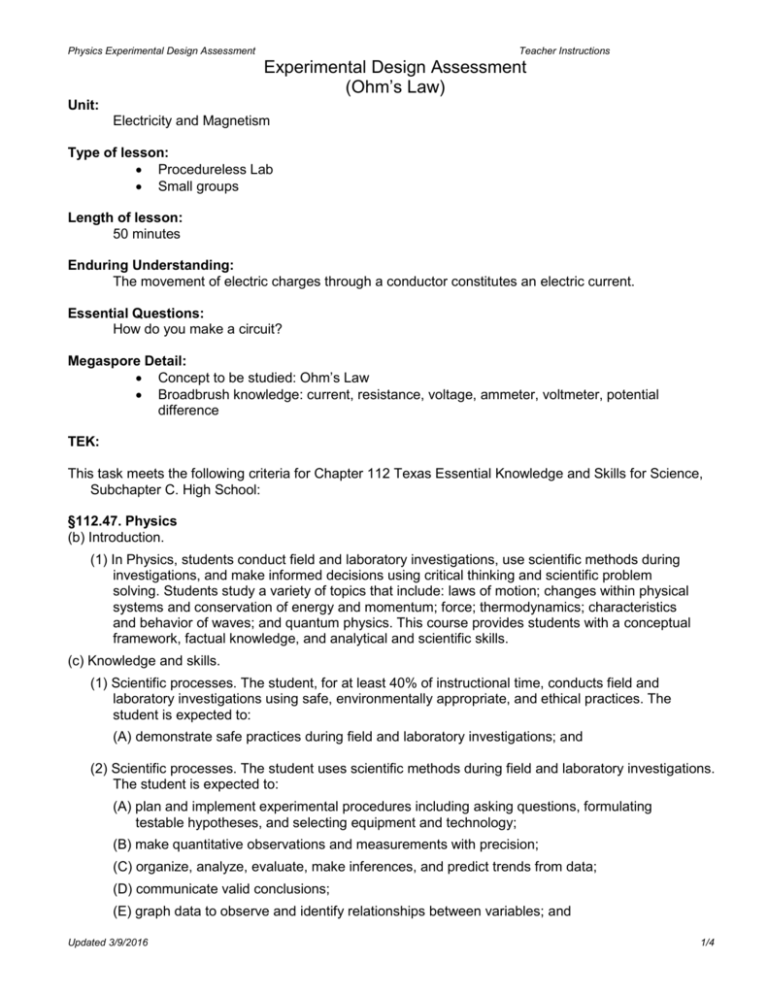Experimental_Design_Physics_Teacher
advertisement

Physics Experimental Design Assessment Teacher Instructions Experimental Design Assessment (Ohm’s Law) Unit: Electricity and Magnetism Type of lesson: Procedureless Lab Small groups Length of lesson: 50 minutes Enduring Understanding: The movement of electric charges through a conductor constitutes an electric current. Essential Questions: How do you make a circuit? Megaspore Detail: Concept to be studied: Ohm’s Law Broadbrush knowledge: current, resistance, voltage, ammeter, voltmeter, potential difference TEK: This task meets the following criteria for Chapter 112 Texas Essential Knowledge and Skills for Science, Subchapter C. High School: §112.47. Physics (b) Introduction. (1) In Physics, students conduct field and laboratory investigations, use scientific methods during investigations, and make informed decisions using critical thinking and scientific problem solving. Students study a variety of topics that include: laws of motion; changes within physical systems and conservation of energy and momentum; force; thermodynamics; characteristics and behavior of waves; and quantum physics. This course provides students with a conceptual framework, factual knowledge, and analytical and scientific skills. (c) Knowledge and skills. (1) Scientific processes. The student, for at least 40% of instructional time, conducts field and laboratory investigations using safe, environmentally appropriate, and ethical practices. The student is expected to: (A) demonstrate safe practices during field and laboratory investigations; and (2) Scientific processes. The student uses scientific methods during field and laboratory investigations. The student is expected to: (A) plan and implement experimental procedures including asking questions, formulating testable hypotheses, and selecting equipment and technology; (B) make quantitative observations and measurements with precision; (C) organize, analyze, evaluate, make inferences, and predict trends from data; (D) communicate valid conclusions; (E) graph data to observe and identify relationships between variables; and Updated 3/9/2016 1/4 Physics Experimental Design Assessment Teacher Instructions (F) read the scale on scientific instruments with precision. (3) Scientific processes. The student uses critical thinking and scientific problem solving to make informed decisions. The student is expected to: (B) express laws symbolically and employ mathematical procedures including vector addition and right-triangle geometry to solve physical problems; (6) Science concepts. The student knows forces in nature. The student is expected to: (E) design and analyze electric circuits; Core Objective: 10. Identify the role electric charge plays in electrostatics and circuits. b. Correctly construct a circuit and measured desired quantities. c. Analyze circuits and apply Ohm’s law and Kirchhoff’s rules Resources: Graphing Skills Sheet Conclusion Skills Sheet Lesson Summary: This task evaluates a student’s ability to design, perform and analyze a lab to determine the relationship between voltage and current for an object of unknown constant resistance. Teacher Instructions: Other than clarifying directions, no further teacher instruction or guidance should be offered during the lab. Teachers should monitor groups to ensure that safe procedures are followed. This task should be considered a lab grade. PRE-LAB ACTIVITIES Students should have been instructed in wiring of simple circuits, wiring and reading ammeters and voltmeters, and wiring series and parallel circuits. Students should receive a copy of the student instructions. Teacher should discuss with the students the expectations and grading criteria of the laboratory assessment. Students should be placed in groups of 3-4 students. LAB ACTIVITY Prepare each lab station with one of the following sets of materials: FOR A VARIABLE POWER SUPPLY: o 2 resistors of unknown resistance (5-15 ) o 4 alligator clip/banana wires o 1 double alligator clip wire o 1 double banana wire o variable power supply o ammeter o voltmeter FOR BATTERIES: o 2 resistors of unknown resistance (5-15 ) o 6-10 wires with clips o 3-5 D-cell batteries o ammeter o voltmeter Updated 3/9/2016 2/4 Physics Experimental Design Assessment Teacher Instructions One group will be stationed per lab table. Each student should first create a hypothesis, procedure and data table. This should take no longer than 20 minutes. Before a group starts the experiment, the teacher should initial each student’s paper to check the procedure for safety issues. After each group has gotten their papers initialed, they may use remaining class time to collect data. POST-LAB After data collection, students will individually complete the following: o A graph representing the relationship between voltage and current using the Graphing Skills Sheet format o A conclusion using the Conclusion Skills Sheet format. o Students will turn in a complete lab write-up including: Purpose, Hypothesis, Data Table, Graph, and Conclusion at a time to be determined by the teacher. The teacher will complete the Points Earned column in the grading rubric to assess points for the total score/grade. Final scores will be marked in Pinnacle as well as in EdSoft. Updated 3/9/2016 3/4 Physics Experimental Design Assessment Teacher Instructions Rubric for Physics Laboratory Skills Assessment on Ohm’s Law CRITERIA MAXIMUM POINTS POINTS EARNED FORM A HYPOTHESIS Student has a valid and testable hypothesis. 5 DETAILED PROCEDURE Student has a detailed procedure listed in a step-by-step format. 5 DATA COLLECTION Design a table with appropriate information and number of trials. 20 ANALYZE DATA Graphical representation of data. Slope calculation with proper units Appropriate scales Title (y vs. x) Best fit curve Labels on axes Use of straight edge 30 CONCLUSION Brief summary of procedure (limit to a few sentences) Restate hypothesis Support or reject hypothesis with data collected from the experiment and an analysis of your graph(s) Sources of experimental error Methods to improve experiment 30 GENERAL Completed task has a neat appearance Uses appropriate vocabulary Uses accurate grammar/writing mechanics TOTAL Updated 3/9/2016 10 100 4/4







